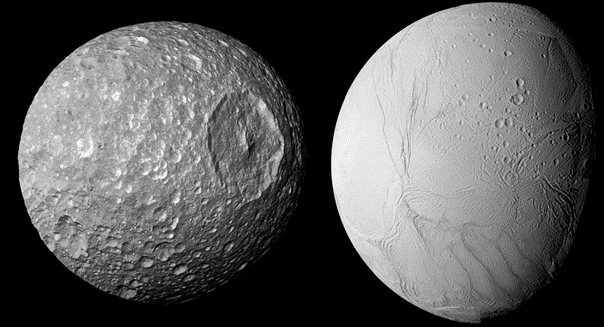Birth of an ocean on Saturn’s moon Mimas
If there’s one object in the Solar System where we wouldn’t expect to find liquid water, it’s undoubtedly Mimas.

Unlike its big sister Enceladus, Mimas’ surface is extremely cratered and inactive, showing no signs of subsurface activity. What’s more, Mimas is a modest moon (around 400 km in diameter), a size that doesn’t allow it to retain its internal heat for long.
By studying the movement of Mimas’ orbit using data from NASA’s Cassini probe, a team of researchers including Gabriel Tobie, a CNRS researcher at the Laboratoire de Planétologie et Géosciences at Nantes Université, has confirmed the presence of an ocean beneath the satellite’s icy surface.
To arrive at this result, the researchers studied the effect of Mimas’ rotation on its orbit. Like most moons in the Solar System close to their planet, Mimas always faces Saturn in the same way. The satellite therefore rotates on itself at the same frequency as its orbital motion. In addition to this average rotation, Mimas is also affected by small oscillations, known as librations. It is precisely the feedback of these librations on orbital motion that the researchers studied.
By comparing the solution derived from numerical models describing Mimas’ orbit with observations provided by the Cassini probe, they discovered that the fine features of Mimas’ orbit can only be explained by the presence of a global ocean hidden between 20 and 30 km beneath the satellite’s surface. Such a configuration is reminiscent of what was discovered a few years ago on the moon Enceladus.
To determine the origin and age of such an ocean, Gabriel Tobie modelled the tidal effects caused by the planet Saturn on Mimas. The calculations showed that the birth of this ocean, dating from only 5 to 15 million years ago, was most certainly caused by the tripling of Mimas’ initial orbital eccentricity, under the gravitational influence of several of Saturn’s other moons. The onset of internal activity is therefore so recent that it explains why no signs of activity have yet been seen on the surface.
Mimas thus joins the very select club of moons with a global water ocean. In fact, it’s the smallest of them all. Unlike other moons, such as Enceladus, where an ocean has already been detected, this is a nascent ocean, offering unique conditions for studying water-rock interaction processes as they may have existed in many bodies during the first ages of the Solar System.
This research work is the subject of an article entitled “A recently-formed ocean inside Saturn’s moon Mimas” by Valéry Lainey (astronomer at Observatoire de Paris – PSL, IMCCE), Nicolas Rambaux (teacher-researcher at Sorbonne Université, IMCCE), Gabriel Tobie (CNRS researcher, Nantes Université), Benoît Noyelles (Lecturer-Researcher, Université Franche-Comté, UTINAM), Kévin Baillié (CNRS researcher, Observatoire de Paris – PSL, IMCCE), Nick Cooper, Honorary Researcher, Paris Observatory – PSL, IMCCE.
Reference : « A recently-formed ocean inside Saturn’s moon Mimas » Valéry Lainey, Nicolas Rambaux, Gabriel Tobie, Benoît Noyelles et Kévin Baillié, february 2024, Nature. https://doi.org/10.1038/s41586-023-06975-9
Published on February 8th, 2024

